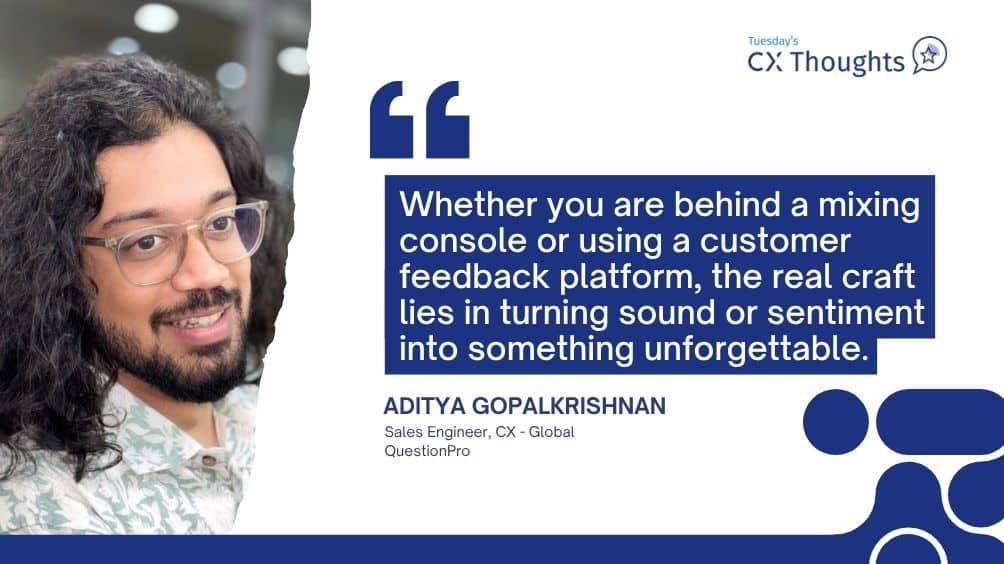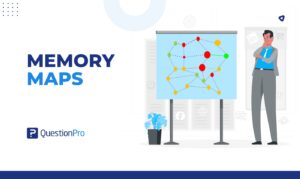
For most of my life, I worked as a freelance audio engineer – shaping sound, layering emotion, and creating moments that people could feel.
Today, I work in Customer Experience with QuestionPro, helping organizations listen to their audiences and design experiences that truly resonate. On the surface, those two worlds – music and CX, couldn’t seem more different. One is driven by rhythm, tone, and harmony; the other by data, design, and empathy.
However, the more I’ve lived in both spaces, the clearer the connection has become. Both audio engineering and customer experience are built on the same foundation. Listening deeply, balancing complexity, and creating emotional impact.
This piece isn’t just about pointing out the similarities between the two; it’s about exploring what CX can learn from the art of sound. Because if an engineer can make a listener feel something through music, then maybe we, too, can make customers feel heard through experience.
1. Listening vs. Hearing
- Audio: In the studio, there’s a difference between hearing sound and listening critically. An engineer doesn’t just notice what’s loud or quiet. They detect tone, texture, and emotion.
- CX: In customer experience, collecting feedback is only “hearing.” True listening means understanding context, emotion, and intent behind customer sentiment.
Lesson: Active listening transforms noise into insight. Whether it’s a vocal track or customer feedback, listening deeply reveals what truly matters.
2. Signal-to-Noise Ratio
- Audio: Achieving clarity means improving the signal-to-noise ratio. Removing what doesn’t belong so the message can shine.
- CX: In feedback analysis, the same is true. Amid the noise of comments and data points, we must identify the clear, consistent signals that indicate what customers value or struggle with.
Lesson: Both worlds reward clarity. The ability to isolate what matters most from everything else.
3. Emotional Resonance
- Audio: Music isn’t just sound. It’s about emotion. Every mix decision. The reverb on a vocal, the balance of frequencies, aims to make the listener “feel”.
- CX: Every touchpoint with a brand is an opportunity to do the same. Make a customer feel understood, supported, and valued.
Lesson: Experience design, like sound design, is about crafting emotion.
4. Feedback Loops and Iteration
- Audio: The process is cyclical. Record, mix, review, tweak, and master. Each iteration brings refinement.
- CX: The same feedback loop exists. Collect, act, measure, and improve. Data alone doesn’t create change – iteration does.
Lesson: Both are living systems that evolve through feedback. Perfection isn’t a one-time act. It’s a process of continuous listening and adjustment.

5. Collaboration and Orchestration
- Audio: No song exists in isolation. Artists, producers, and engineers come together, each contributing a layer that builds the complete experience.
- CX: Customer experience is the sum of collaboration across departments. Marketing, sales, product, support, and leadership all play a part in shaping the journey.
Lesson: True harmony is achieved through alignment, not just individual excellence.
6. Tools and Systems Thinking
- Audio: Engineers use compressors, EQs, and routing chains to sculpt sound. But the craft lies in knowing when to use them and when not to.
- CX: Automation, APIs, dashboards, and AI serve the same purpose. They’re tools to shape, not replace human understanding.
Lesson: Mastery isn’t technical. It’s intentional. Knowing how each tool contributes to the final experience.
7. The Art of Silence
- Audio: Silence gives music breath and contrast. It’s the space that makes sound meaningful.
- CX: Sometimes the most powerful thing in customer interaction is pause. Giving space for the customer to speak, reflect, or simply feel heard.
Lesson: Empathy lives in restraint. Not every gap needs to be filled; sometimes silence communicates care.
8. The Art of Orchestration
- Audio: A great mix isn’t about making one instrument shine. It’s about ensuring every part supports the overall emotion. The drums, bass, and vocals must complement each other to create one unified experience.
- CX: Customer experience works the same way. It’s not a single touchpoint, team, or metric. It’s the harmony between them. Marketing sets the tone, sales adds melody, support maintains rhythm, and product delivers the resolution.
Lesson: Both are amalgamations of smaller parts that come together to form something greater than the sum. The magic isn’t in the pieces. It’s in how they blend to make people feel something real.
Conclusion
Whether you’re shaping sound or designing experiences, the principles remain the same:
- Listen deeply.
- Filter noise.
- Collaborate intentionally.
- Design for emotion.
At their core, both audio engineering and customer experience strive for the same goal: connection. Not perfection, but resonance. The kind of experience that stays with people long after the moment has passed.
That’s what we believe in at QuestionPro. Listening is not a checkbox; it is an art. Data can sing when you know how to tune it. And great experiences, like great songs, are not simply built – they are composed.
Whether you are behind a mixing console or using a customer feedback platform, the real craft lies in turning sound or sentiment into something unforgettable.






